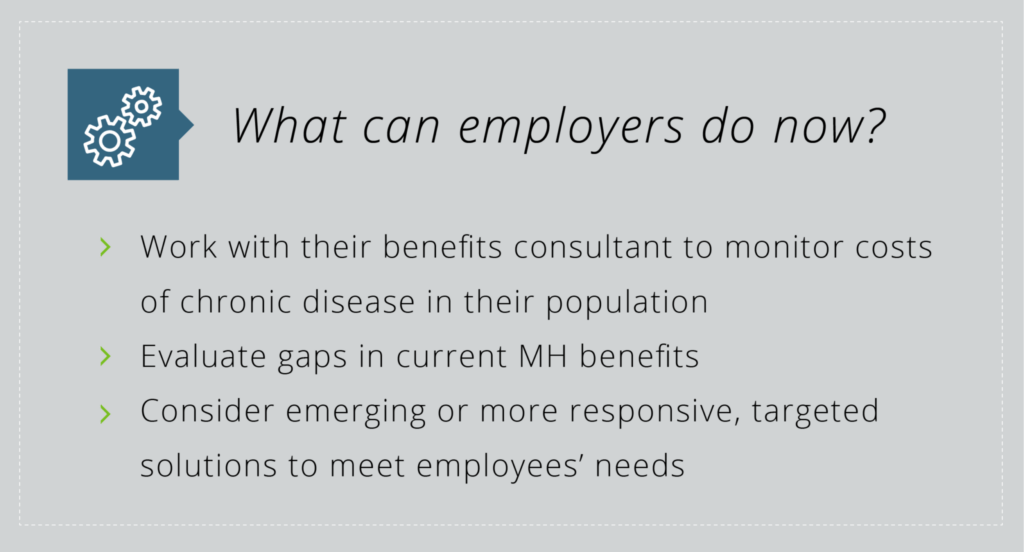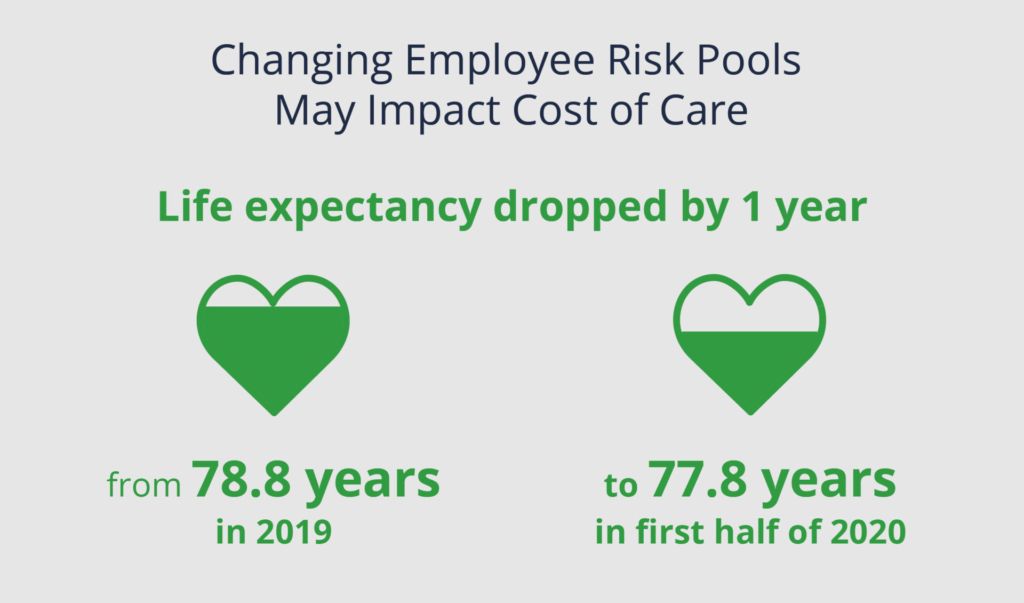Guide
Looking Ahead Part 3: Employer Challenges and a Practical Guide to Employee Benefits for the Future
This is the third in a series of four articles in our Looking Ahead Guide to Employee Benefits in 2021. Our goal is to help employers set the stage for new opportunities in their Employee Benefits programs.
In Looking Ahead Part 1, we discussed how employers reviewed their benefits strategies, invested in remote work, and created novel employee communication programs. The silver lining of 2020 taught us to be resilient and continuously adapt to rapid change.
Looking Ahead Part 2 elaborated on the decisions that employers are faced with about what programs are here to stay in post-pandemic benefit programs, which programs require additional resources, and how their workforces are permanently changed.
In Looking Ahead Part 3, we review four primary employer challenges and how they must face them for the immediate future.
Four Top Employee Benefits Priorities Have Emerged
The year 2020 was a time of tactical responses to rapidly changing conditions. Employers operated in crisis mode, making decisions that kept their businesses running. In 2021, we are just learning the implications of our profound economic and societal changes, but we don't yet know for sure what the outcome will be.
Vaccine policies, chronic disease and mental health benefits, delivering on employee benefit monitoring, and cost control are the four top challenges that employers will likely deal with on the road ahead. We will outline the current challenges and suggest how employers should navigate these uncertain waters.
Priority #1: Employers and the Vaccine Rollout
Public safety is now a business issue, making it a top mandate for employers. They must pivot their operations to be safer and cleaner. WFH, social distancing, and other measures must be implemented in the physical environment and embedded in the company culture. However, these protocols will only go so far in protecting the workforce. Like it or not, employers will play an important role in the vaccine rollout.
Employers provide over 50% of all healthcare insurance in the US. Employees and their families look to them as a trusted source of information and guidance. While convoluted, the vaccine rollout is rapidly gaining momentum. Employers will need to have a point of view, a strategy, and an action plan for integrating vaccine delivery within their employee population.
In a recent employer survey1, less than 1% of employers, including healthcare organizations, will mandate that employees get vaccinated, while approximately 18%-23% are considering such a move. The primary reasons for not enforcing vaccinations are compliance issues, employee concerns about vaccine safety, and potential liability in the event of a bad reaction to the vaccine. The same study indicated that half of the employers strongly encourage vaccinations, creating communication plans that raise awareness.
In general, most employers are choosing to encourage or incentivize their workforce to get vaccinated. Some are offering small incentives, including PTO incentives or time off, in the event of a bad reaction to the vaccine, while a small percentage provide gift cards and cash incentives. The EEOC typically limits cash wellness incentives, but recently AMTRAK announced a $3 million incentive program to get all of their 16,500 workers vaccinated, with other employers making similar investments. Most employers will rely on federal and state agencies for vaccine rollouts but may offer onsite events if not cost-prohibitive.
The vaccine issue will intensify in the coming year as vaccines become more widely available. About one-quarter of employers will discuss options with public health officials and carriers, while 18% will assist with vaccine distribution in their local regions. Overall, employers are taking a wait-and-see approach, developing more detailed plans as the vaccination rollout progresses.
A survey indicates that approximately two-thirds of employees would voluntarily get the vaccine, but nearly 25% would resist if their employer mandated it.
Employers can expect friction between those who will and will not be vaccinated, so setting clear expectations will be needed. For some organizations, employee vaccinations are not just a public safety concern but a business continuity issue.
Employers must execute their policies per EEOC guidelines, which continue to evolve. Under the ADA, employers can have a policy that includes "a requirement that an individual shall not pose a direct threat to the health or safety of individuals in the workplace." Employers would have to prove that unvaccinated workers are a "direct threat" due to a "significant risk of substantial harm to the health or safety of the individual or others that cannot be eliminated or reduced by reasonable accommodation." Employers can consider a reasonable accommodation, such as a work-from-home arrangement or leave of absence. Religious accommodations should also be evaluated, but employers should follow the most recent EEOC guidance and create a written vaccination policy.
| Things to consider in a vaccine rollout strategy for employees: |
|---|
| Develop a vaccination education campaign to keep employees informed. |
| Make getting the vaccine as easy as possible for employees. |
| Cover any costs that might be associated with getting the vaccine. |
| Provide incentives to employees who get vaccinated. |
| Provide paid time off for employees to get the vaccine and recover from any potential side effects. |
The Road Ahead: Develop your Vaccine Policy
Employers will have to define their vaccination strategy, including mandated or voluntary perspectives. Experts advise that employers create a written policy that outlines expectations while staying compliant with ADA and Civil Rights Act laws.
Where incentives are involved, ensure they are compliant with EEOC guidelines. We recommend staying in close contact with your benefits consultant to ensure vaccinations are covered under medical and pharmacy plans. Update PTO plans to allow for time off for vaccinations and potential recovery time for vaccine reactions. Vaccination strategy starts at the top, with employers monitoring the rollout and developing internal plans that enhance employee safety while balancing federal and state employment laws.
Vaccination policy communication is an integral part of an effective policy. Educational campaigns are critical to raising awareness while lowering uncertainty. Where possible, facilitate the process by helping employees obtain the vaccine while covering out-of-pocket costs and communicating PTO options for any side effects. Executives can set an example for others to follow by also getting the vaccine.
Employers should expect that some employees will not choose to be vaccinated. To avoid conflict, help managers and supervisors to recognize that some workers may be asking for an ADA-related accommodation or may just be looking for encouragement because of lack of awareness. Managerial support of an employer’s policy will be critical to their effectiveness.
Priority #2: Address Chronic Disease and Mental Health Hurdles
COVID cases have rightfully been the primary focus of the healthcare system. However, people with chronic disease have often gone untreated, increasing the potential that people with heart disease and stroke, kidney disease, cancer, and similar diseases now have more advanced stages of their condition. Neglected chronic disease is now considered the “The Invisible Epidemic," with screening tests and new medications showing steep declines during the pandemic.
Preventive screenings for cervical, colon, and breast cancer dropped 86%-94% after the onset of the pandemic, making it difficult for the healthcare system to play catch-up or assume a normal schedule. One report indicated that there may be as many as 36,000 missed cases of breast cancer between March to June of 2020. Doctors are encouraging patients to take at-home cancer screening tests to compensate for the lack of routine screening in addition to telehealth appointments with their physicians.

Employees have not been able to get the traditional levels of care, especially for chronic disease, that they received pre-pandemic. Experts expect the health system to deal with sicker patients as one report indicated that 56% of people with multiple complex chronic conditions has delayed care. We would be remiss if we did not address the growing mental health crisis and the role that all employers play in providing essential mental health resources for employees and their families. The pandemic has resulted in a massive increase in the need for mental health services, and employers are in a place to make a pivotal impact.
The Road Ahead: Monitor Untreated Chronic Diseases and Mental Health Benefits
Chronic disease treatment for heart disease, diabetes, and cancer will continue to be the top issues for employees, mostly if left untreated. Employers can position themselves to offer emerging solutions that treat these diseases and help control costs, improving the health of compromised employees. They should also work closely with their benefits consultant to monitor chronic disease-related cost increases. To address growing mental health treatment issues, employers should consider changing their program to more responsive EAP providers or offer apps and expanded mental health benefits. Telehealth benefits are also growing, but communicating those benefits is critical to encourage utilization.

Priority #3: Deliver on Employee Benefits Value
Employee benefits represent 30% of the employees' total wages. Yet employees understand relatively little about their value or use. – The Bureau of Labor Services
The benefits communication landscape is undergoing a revolution. Due to social distancing, WFH, and new safety protocols, face-to-face discussions are no longer an option. Historically, employers relied on in-person interactions to ensure employees made appropriate benefit choices. Without traditional personalized HR engagement, employers must look to new communication options.
Communicating benefits information requires meeting your employees where they are, including new options like Jellyvision, virtual meetings, postcards, HR Leadership welcome videos, mixed media targeted to spouses, and more. Companies are also using organizational influencers (a traditionally under-utilized approach) to promote enrollment, including floor supervisors walking their teams through the enrollment process with tablets and personal attention.
The content and context of benefits are also changing. Social inequities have heightened the need for diversity, equity, and inclusion (DEI), forcing employers to engage all employees and their unique needs. The types of benefits they offer and how they communicate the value of those benefits will be critical.
Despite the increase in the number of communication channels, gaps still exist. More communication does not mean better communication. Employers must even do a better job of addressing all employee groups, including non-English speakers and generational preferences. Employers need a comprehensive plan that uses a consistent voice and new tools to communicate the value of benefits to all employees
The Road Ahead: Use Comprehensive Approaches for More Effective Communication
Traditional in-person engagement is declining, with HR departments no longer personally advising employees on benefit choices. Employers will continue to look to cost-effective digital tools that deliver information while helping employees make wise choices. Employers will offer a suite of benefits that reflect employees' needs and launch more focused campaigns to increase awareness and deliver value. These requirements point to re-thinking benefits budgets, investing more dollars into marketing and awareness campaigns that include a growing hybrid of digital tools and personalized support.

Your HR team is responsible for employee engagement and benefits administration but must overcome visibility issues that arise because they do not interact with executive leadership daily. Executive leadership should stay engaged with HR to understand their changing workforce better, what support they need, and how to remain engaged to deliver value on their benefits investment.
Finally, employers cannot just rely on tools to get their message out to their employees. They also need to develop a personalized company voice that improves the one-to-one connection with employees, not just the content. In addition to digital engagement tools, employers can also invest in podcasts, videos, and digital events that create a personal connection despite physical distances. This human-to-human connection presents challenges to leaders who are used to a top-down communication approach but can lead to higher engagement in the long run.
Priority #4: Underwriter COVID-19 Cost Uncertainties Will Impact Employer Renewals
The American Hospital Association reported over $320 billion in estimated losses for 2020, more than three dozen hospital bankruptcies, and hospital margins declined by 7%. Hospital systems were pushed to the brink, where LA County hospitals became overwhelmed after reporting over 1.1 million COVID cases and over 16,700 fatalities. One year later, cases are beginning to decline after a disheartening holiday surge.
The primary source of hospital revenue is elective procedures, which are still on hold. Nearly all medical disciplines are anxious to ramp up services, but no clear date is in sight. Healthcare systems face continuing financial risk the longer that procedures are delayed.
Revenue losses, hospital closures, COVID treatment costs, and untreated chronic illnesses, and increased unemployment will undoubtedly have a far-reaching impact on the health insurance industry. Carriers are experiencing pressures on claims reserves, uncertainty in collecting premiums, and even more significant premium uncertainty since overall costs have yet to be calculated.
Employee risk pools are also changing based on the far-reaching health impacts of COVID and untreated illnesses. For the first time in decades, life expectancy dropped overall by 1.2 years for males and .9 years for females, with steeper declines for blacks and Hispanics. The culprit was COVID-19, but also an increase in drug overdoses, according to the CDC.

These indicators have yet to be fully comprehended or quantified by underwriters. As health systems, carriers, and employers still deal with the pandemic's direct impact, underwriters will need to calculate the cost—and who will pay for it. They will continue to assess the risk pool, including vaccinations, treatments, and the resulting health impacts.
The Road Ahead: Underwriting Expertise is Needed to Help Monitor Your Costs
Employers’ 2020-2021 claims experience will be very “noisy” due to pandemic disruptions and renewals offered in 2021 may be influenced by carrier-provider contract negotiations. You should ensure your benefits consultant has the underwriting discipline to separate fact from fiction in your plan’s performance.
Cost monitoring continues to be essential. As underwriting determines the pandemic's actual cost, employers should work closely with their benefits consultants to design strategies that address the needs of their workforce and their changing needs. It will require analysis of market trends, market presence, and sophisticated data analytics tools to understand their organization's impact.
It’s Time to Keep Your Employee Benefits Strategy Moving Forward
It is time to evaluate, solicit critical feedback from your leadership team, and design your road forward.
Woodruff Sawyer benefits consultants can help you pivot your benefits strategy during challenging times. Let us help you travel the road ahead by creating benefits that reflect your workforce's changing needs.
Public safety is now a business issue. What role will employers be expected to play in the vaccination of their employees? Join our COVID-19 Vaccine Strategy in Today’s Workplace webinar, where we answer your questions about COVID-19 vaccines in today’s workplace.
Footnote: 1. 2021 pandemic survey series: a focus on vaccines, Mercer
Author
Table of Contents












